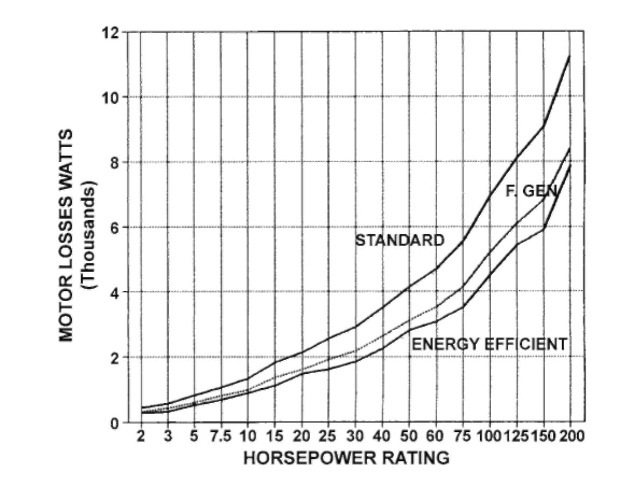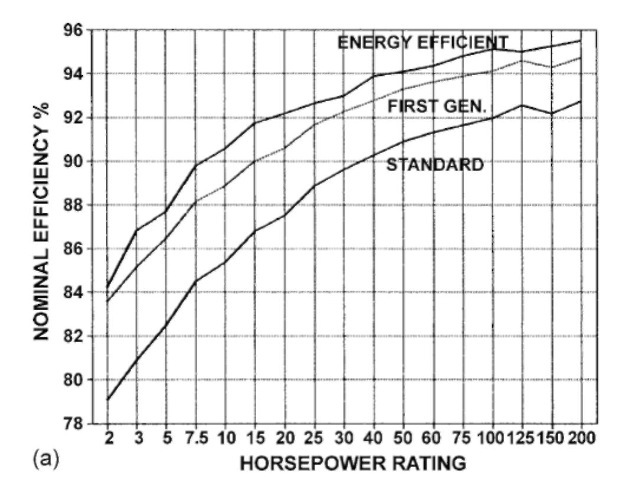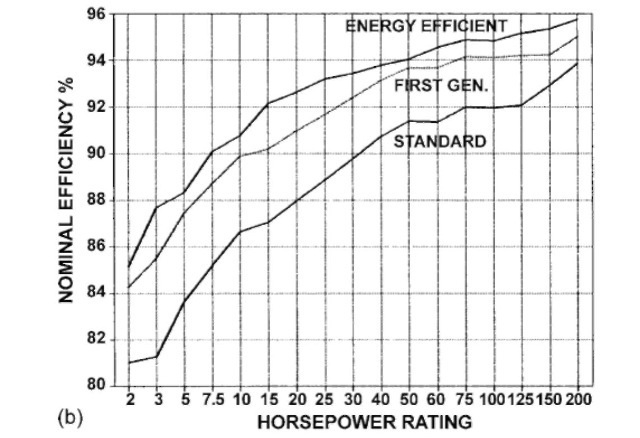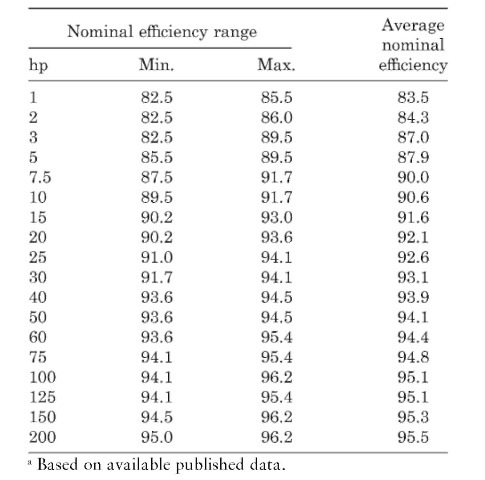2.4
Until recently,
there was no single definition of an energy-efficient motor. Similarly, there were no efficiency standards for standard NEMA design B polyphase induction motors. As discussed earlier, standard motors were designed with efficiencies high enough to achieve the allowable temperature rise for the rating. Therefore, for a given horsepower rating, there is a considerable variation in efficiency. This is illustrated in Fig. 2.1 for the horsepower range of 1-200 hp.
In 1974, one electric motor manufacturer examined the trend of increasing energy costs and the costs of improving electric motor efficiencies. The cost/benefit ratio at that time justified the development of a line of energy-efficient motors with losses approximately 25% lower than the average NEMA design B motors. This has resulted in a continuing industry effort to decrease the watt losses of induction motors. Figure 2.3 shows a comparison between the full-load watt losses for standard four-pole, 1800-rpm NEMA design B induction motors, the first-generation energy-efficient motors with a 25% reduction in watt losses, and the current energy efficient motors. The watt loss reduction for the current energy-efficient four-pole, 1800-rpm motors ranges from 25 to 43%, with

FIGURE 2.3 Full-load losses, standard NEMA Design B 1800-rpm motors versus first-generation energy-efficient motors (25% loss reduction) and current energy-efficient motors.
an average watt loss reduction of 35%. Figures 2.4a and 2.4b illustrate the nominal efficiencies of the current energy-efficient (E.E.) motors, the first-generation energy-efficient motors (25% loss reduction), and current standard NEMA design B four-pole, 1800-rpm motors.
Subsequent to the development of this first line of energy-efficient motors, all major electric motor manufacturers have followed suit. Since, as previously discussed, there was no standard for the efficiency of motors, the energy-efficient motors of the various manufacturers can generally be identified by their trade names. In addition, these


FIGURE 2.4 (a) Nominal full-load efficiency comparison 1800-rpm open induction motors. (b) Nominal full-load efficiency comparison 1800-rpm TEFC induction motors.
products are supported by appropriate published data. Following are examples of these trade names and their manufacturers:
| E-Plus®, E + in® | Magnet ek |
| Energy Saver™ | General Electric |
| XE Energy Efficient | Reliance Electric Co. |
| Super E | Baldor Electric Co. |
| Spartan High Efficiency | Magnetek/Tjouis Allis |
| Corro-Duty Premium Efficiency | U.S. Electrical Motors |
| Premium Efficiency | Division of Emerson Electric |
| Co. Seimens | |
| Premium Efficiency | Toshiba/Houston Intl. |
A survey of the published data available from the manufacturers of energy-efficient motors is summarized in Table 2.4 and Fig. 2.5. These data show the nominal average efficiency as well as the range of nominal efficiencies expected. The efficiencies are shown as nominal efficiencies as defined in NEMA Standards Publication MG1. When these efficiency data are compared to the standard motor efficiency data shown in Fig. 2.1, the range in efficiency for a given horsepower is considerably less; in other words, energy-efficient motors tend to be more uniform than standard motors.
When the average nominal efficiency for industry energy-efficient motors shown in Tables 2.4a and 2.4b is compared to the data shown in Fig. 2.4 for standard motors, the industry average is consistently higher. When the average efficiency for standard motors in Fig. 2.1 is compared to the average efficiency for current energy-efficient motors in Figs. 2.5a and 2.5b the average loss reduction is 35%, thus indicating a continuing trend to higher-efficiency motors. These improvements in efficiency, or loss reductions, are generally achieved by increasing the amount of active material used in the motors and by the use of lower-loss magnetic steel. Figure 2.6 shows this comparison of a standard motor and an energy-efficient motor for a particular horsepower rating. In addition to increasing the motor efficiency, there are other user benefits in the application of energy-efficient motors, which will be discussed in more detail in
TABLE 2.4a Full-Load Nominal Efficiencies of Three-Phase Four-Pole Energy-Efficient Open Motors”

topic 5. This trend will probably continue as the cost of power and the demand for higher-efficiency motors continue to increase. Figure 2.7 shows the trend in the loss reduction and efficiency improvement of a 50-hp polyphase induction motor. Other induction motors from 1 to over 200 hp have followed a similar trend.
